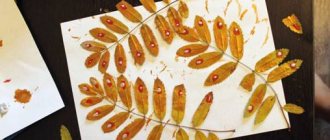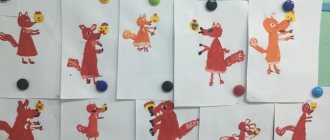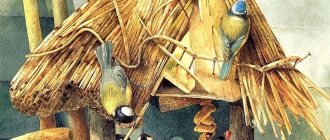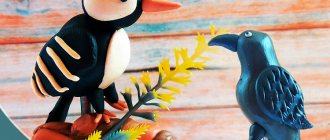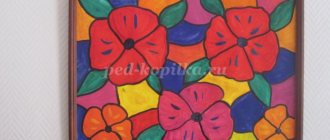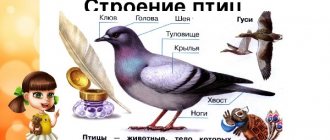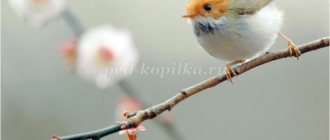Drawing domestic and migratory birds: lesson notes
| Author's full name | Title of the abstract |
| Volokhova O. | "Brave Cockerel" Educational objectives: learn to draw a cockerel with watercolors, conveying its characteristic features and creating an expressive image. Developmental tasks: develop color perception, sense of proportions, improve brush painting technique. Educational tasks: cultivate love and caring attitude towards poultry. Integration of educational areas: “Artistic creativity”, “Cognition”, “Communication”, “Socialization”, “Health”. Demo material: a picture of a rooster, an audio recording of a rooster crowing. Handout: sheets of white paper according to the number of children, watercolors, sippy cups, brushes, coasters, napkins. Progress of the lesson: Teacher's story about a rooster. It turns out that this bird was not always domestic. The ancestors of the rooster from India and China lived in the forest in trees and built nests on the ground. Loud singing was their protection from other birds. Domestic roosters have not lost this habit either. Villagers tell the time by the crow of a rooster. “The first roosters” sound at one o’clock in the morning, an hour later the second roosters sound, and at four o’clock the rooster’s voice is heard throughout the village, announcing that dawn will soon come. The guys look at the image of a rooster and a hen with a chicken, find out how they differ. The rooster is larger, it has a crest on its head, “spurs” on its legs (sharp claws for protection), and bright plumage, especially the tail. The teacher reads a poem about a cockerel.
A conversation about the character of the rooster in this work (brave, courageous, courageous, capable of protecting hens and chicks). He is like this in almost all fairy tales. The teacher asks the children in which fairy tales the cockerel appears. The teacher reports that since ancient times, people believed that the crow of a cock protects the house and embroidered the image of a rooster on towels, tablecloths, and painted it on dishes and furniture. Preschoolers are also asked to pretend to be a rooster. The game “Fighting Roosters” is played: two participants hide their hands behind their backs and, standing on one leg, try to push the opponent out of the circle (with their shoulder or torso). Independent work - drawing a cockerel. Exhibition of children's works. The teacher sums up the lesson and says that the cockerels will protect the children from adversity. |
| Geleverina Yu. | "Wintering Birds" The lesson begins with a game with a ball: children, standing in a circle, take turns naming the bird. Conversation about birds: · Where we meet them (in the city, in the forest, on reservoirs). · how they differ from each other (size, color, singing, habitat) · Where they find food in winter (in feeders, berries on trees). · What can be put in the feeder (bread, grains, seeds, lard). · How birds keep themselves warm in winter (they tuck their legs under them and hide them in the fluff). The didactic game “Cut Pictures” is played: children in pairs pick out images of birds. Physical school is carried out:
Didactic game “Finish the sentence (for example, a magpie is a wild bird, and a chicken...). The teacher reads the poem “Feeder”
Children are invited to draw a wintering bird of their choice. |
| Borodacheva O.V. | "Owl" The lesson begins with a riddle about an owl:
The teacher recalls with the children the fairy tale “The Owl” by V. Bianchi, and knowledge about the significance of this bird in nature is consolidated. Looking at pictures of an owl. Highlighting its distinctive features: large head and eyes, almost no neck, thick plumage. Rounded wings and a short tail help this bird fly silently. The owl's eyes, although large, see practically nothing. Since this bird is a predator, it has a powerful curved beak and sharp claws. The didactic game “Who Says What” is played (children reproduce the voices of various birds). Physical exercise "Owl"
The teacher explains the principle of drawing an owl, and then the children begin the practical part of the lesson (the owl is drawn sitting on a tree branch). Analysis of children's drawings: the teacher asks to highlight the largest owl, the smallest, as well as the sad and cheerful one. The outdoor game “Day and Night” is played. |
| Fomina I.A. | "Swan" At the beginning of the lesson, the teacher tells the children that an artist she knows gave her black and white pictures. We need to figure out together what is depicted on them - the children are shown slides depicting silhouettes of different birds. Preschoolers name them, highlighting characteristic features for each (for example, a swallow has a forked tail, a stork has a long neck, legs and beak). The conclusion is that all these birds are migratory. The didactic game “Finish the sentences” is played (all phrases are related to the swan). Demonstration of a sample image of a swan (swimming in the lake). Discussion on how to complete the drawing. Before working independently, children warm up their fingers by rolling a pencil between them. Independent activity of children. Exhibition of works. The teacher appoints one of the children as a tour guide, and he talks about the children’s works. |
Summary of an open lesson on fine art in the preparatory group “Birds in Spring”
Summary of an open lesson on fine arts in the preparatory group
"Birds in Spring"
Goals and objectives:
- Foster a love of nature.
— Develop the creative abilities and cognitive interests of preschoolers.
— introduce paintings by Russian artists about spring
-Develop imagination, thinking, coherent speech, observation;
— To consolidate children’s knowledge about spring phenomena in nature, the ability to notice changes in nature and convey them using drawings.
-Develop the skill, the ability to depict a bird and its nest, based on generalized ideas about birds. Learning to use a variety of techniques for working with graphic materials (end, flat, shading) in the process of performing a plot drawing.
— Cultivate accuracy when performing drawings.
Preliminary work.
Reading V. Bianchi’s “Sinichka calendar” March, April; V. Snegirev “Starling”. Learning poems, proverbs, sayings on the topic.
Acquaintance with the work of the artist A. Savrasov. Examination of reproductions of paintings, books, postcards, illustrations depicting birds and their nests.
Equipment:
Presentation with reproductions of paintings, audio recording of the work by F. Chopin - “Spring Waltz”, phonogram with a recording of the voices of birds in the spring forest; Sanguine and charcoal chalk.
Progress of the lesson
The teacher gathers the children around him.
Q - Guys, guests came to our lesson today, let’s say hello to them. Children greet guests.
I have prepared a surprise for you, sit on the carpet, close your eyes and listen
Ready?
I turn on a video with bird sounds
Q. What did you hear?
D. Birds singing
Q. When can you hear such birds singing?
D: This happens in the spring.
Educator:
Our land is beautiful in all seasons. But there is a time in nature when everything seems to wake up and live in anticipation of warmth and sun.
Spring gives everyone the joy of new life and the expectation of a miracle. Joy inspires, makes you act and create. This feeling covers all people: poets write poems, composers compose music, and artists paint pictures.
V.: And I want to invite you to an art gallery and show you paintings by great artists about this wonderful time of year.
Show presentation
IN:
Composers write music using notes, words and rhymes help the poet, and artists express their emotions using what?
D:
.. artists paint not only with paints. Look, what do you think is used in this picture? And it was written in sanguine.
